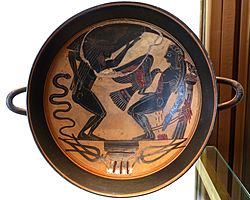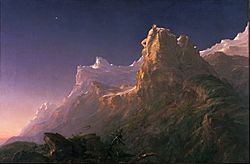Prometheus facts for kids
Quick facts for kids Prometheus |
|
|---|---|
| God of forethought and crafty counsel, culture hero, and trickster figure in Greek mythology | |
 |
|
| Abode | Mount Olympus |
| Personal information | |
| Children | Deucalion |
| Parents | Iapetus and Asia or Clymene |
| Siblings | Atlas, Epimetheus, Menoetius, Anchiale |
In Greek mythology, Prometheus ( Ancient Greek: Προμηθεύς possibly meaning "forethought") is a Titan god of fire. Prometheus is best known for stealing fire from the gods and giving it to humanity. The fire often stands as the symbol of technology, knowledge, and more generally, civilization. Zeus, king of the Olympian gods, decided to punish Prometheus for this act and sentenced him to eternal torment.
Prometheus was bound to a rock, and an eagle was sent every day to eat his liver. His liver would then grow back overnight, only to be eaten again the next day. According to the myth, Prometheus was eventually freed by the hero Heracles.
Etymology
Prometheus most probably means "forethought", as his brother's name (Epimetheus) means "afterthought". Another theory is that the word has Proto-Indo-European roots and means "thief".
Myths and legends
The oldest record of Prometheus is in Hesiod, but stories of theft of fire by a trickster figure are widespread around the world. Some other aspects of the story resemble the Sumerian myth of Enki (or Ea in later Babylonian mythology), who was also a bringer of civilization who protected humanity against the other gods, including during the great flood, as well as created man from clay. While the theory lost favour in the 20th century that Prometheus descends from the Vedic fire bringer Mātariśvan, it was suggested in the 19th century and is still supported by some.
Orgins
The first recorded account of the Prometheus myth appeared in the late 8th-century BC Greek epic poet Hesiod's Theogony.
In that account, Prometheus was a son of the Titan Iapetus by Clymene or Asia, one of the Oceanids. He was brother to Menoetius, Atlas, and Epimetheus.
Worship
During the Archaic and Classical periods people did not worship Prometheus. He was only worshipped in Athens, alongside Athena and Hephaestus.
There was the altar of Prometheus in the grove of the Academy. For the Panathenaic festival, a torch race began at the altar. The race then travelled to the heart of the city, where it kindled the sacrificial fire on the altar of Athena on the Acropolis to conclude the festival. According to Pausanias (2nd century AD), the torch relay was called lampadedromia or lampadephoria, and was in honour of Prometheus.
By the Classical period, the festival of Prometheus was the Prometheia. People wore wreaths that symbolised the chains of Prometheus.
A few other religious sites in Greece were devoted to Prometheus. Both Argos and Opous claimed to be Prometheus' final resting place, each erecting a tomb in his honour. The Greek city of Panopeus had a cult statue that was supposed to honour Prometheus for having created the human race there.
In art
Prometheus' torment by the eagle and his rescue by Heracles were popular subjects in vase paintings of the 6th to 4th centuries BC.
Prometheus was featured in many philosophical works and plays written in Ancient Greece. Some two dozen Greek and Roman authors retold and further embellished the Prometheus myth.
Prometheus has been depicted in a number of well-known artworks in the Middle Ages, the Renaissance, and the modern era.
Classical music, opera, and ballet
Numerous works of classical music, opera, and ballet were directly or indirectly inspired by the myth of Prometheus. These have included the symphonic poem by Franz Liszt titled Prometheus from 1850, among his other Symphonic Poems (No. 5, S.99). Alexander Scriabin composed Prometheus: Poem of Fire, Opus 60 (1910), also for orchestra. In the same year Gabriel Fauré composed his three-act opera Prométhée (1910). Charles-Valentin Alkan composed his Grande sonate 'Les quatre âges' (1847), with the 4th movement entitled "Prométhée enchaîné" (Prometheus Bound). Beethoven composed the score to a ballet version of the myth titled The Creatures of Prometheus (1801).
An adaptation of Goethe's poetic version of the myth was composed by Hugo Wolf, Prometheus (Bedecke deinen Himmel, Zeus, 1889), as part of his Goethe-lieder for voice and piano, later transcribed for orchestra and voice. An opera of the myth was composed by Carl Orff titled Prometheus (1968), using Aeschylus' Greek language Prometheia. A tradition has of course grown among critics of finding allusions to Prometheus Bound in Richard Wagner's Ring cycle.
Rudolf Wagner-Régeny composed the Prometheus (opera) in 1959. Another work inspired by the myth, Prometeo (Prometheus), was composed by Luigi Nono between 1981 and 1984 and can be considered a sequence of nine cantatas. The libretto in Italian was written by Massimo Cacciari, and selects from texts by such varied authors as Aeschylus, Walter Benjamin and Rainer Maria Rilke and presents the different versions of the myth of Prometheus without telling any version literally.
Interesting facts about Prometheus
- In some myths, Prometheus is also credited with the creation of humanity from clay.
- Prometheus is known for his intelligence and for being a champion of mankind.
- He is also generally seen as the author of the human arts and sciences.
- The ancient Greeks identified the rock Prometheus was bound to as Mount Elbrus or Mount Kazbek, in the Caucasus Mountains.
- He was actively worshipped mainly at Athens.
- In the Western classical tradition, Prometheus became a figure who represented human quest for scientific knowledge and the risk of overreaching.
- Mary Shelley gave The Modern Prometheus as the subtitle to her novel Frankenstein (1818).
- The artificial chemical element promethium is named after Prometheus.
Genealogy
| Prometheus's family tree | |||||||||||||||||||||||||||||||||||||||||||||||||||||||||||||||||||||||||||||||||||||||||||||||||||||||||||||||||||||||||||||||||||||||||||||||||||||||||||||||||||||||||||||||||||||||||||||||||||||||||||||||||||||||||||||||||||||||||||||||||||||||||||||||||||||||||||||||||||||||||||||||||||||||||||||||||||||||||||||||||||||||||||||||||||||||||||||||||||||||||||||||||||||||||||||||||||||||||||||||||||||||||||||||||||||||||||||||||||||||||||||||||||||||||||||||||||||||||||||||||||||||||||||||||||||||||||||||||||||||||||||||||||||||||||||||||||||||||||||||||||||||||||||||||||||||||||||||||||||||||||||||||||||||||||||||||||||||||||||||||||||||||||||||||||||||||||||||||||||||||||||||||||||||||||||||||||||||||||||||||||||||||||||||||||||||||||||||||||||||||||||||||||||||||||||||||||||||||||||||||||||||||||||||||||||||||||||||||||||||||||||||||||||||||||||||||||||||||||||||||||||||||||||||||||||||||||||||||||||||||||||||||||||||||||||||||||||||||||||||||||||||||||||||||||||||||||||||||||||||
|---|---|---|---|---|---|---|---|---|---|---|---|---|---|---|---|---|---|---|---|---|---|---|---|---|---|---|---|---|---|---|---|---|---|---|---|---|---|---|---|---|---|---|---|---|---|---|---|---|---|---|---|---|---|---|---|---|---|---|---|---|---|---|---|---|---|---|---|---|---|---|---|---|---|---|---|---|---|---|---|---|---|---|---|---|---|---|---|---|---|---|---|---|---|---|---|---|---|---|---|---|---|---|---|---|---|---|---|---|---|---|---|---|---|---|---|---|---|---|---|---|---|---|---|---|---|---|---|---|---|---|---|---|---|---|---|---|---|---|---|---|---|---|---|---|---|---|---|---|---|---|---|---|---|---|---|---|---|---|---|---|---|---|---|---|---|---|---|---|---|---|---|---|---|---|---|---|---|---|---|---|---|---|---|---|---|---|---|---|---|---|---|---|---|---|---|---|---|---|---|---|---|---|---|---|---|---|---|---|---|---|---|---|---|---|---|---|---|---|---|---|---|---|---|---|---|---|---|---|---|---|---|---|---|---|---|---|---|---|---|---|---|---|---|---|---|---|---|---|---|---|---|---|---|---|---|---|---|---|---|---|---|---|---|---|---|---|---|---|---|---|---|---|---|---|---|---|---|---|---|---|---|---|---|---|---|---|---|---|---|---|---|---|---|---|---|---|---|---|---|---|---|---|---|---|---|---|---|---|---|---|---|---|---|---|---|---|---|---|---|---|---|---|---|---|---|---|---|---|---|---|---|---|---|---|---|---|---|---|---|---|---|---|---|---|---|---|---|---|---|---|---|---|---|---|---|---|---|---|---|---|---|---|---|---|---|---|---|---|---|---|---|---|---|---|---|---|---|---|---|---|---|---|---|---|---|---|---|---|---|---|---|---|---|---|---|---|---|---|---|---|---|---|---|---|---|---|---|---|---|---|---|---|---|---|---|---|---|---|---|---|---|---|---|---|---|---|---|---|---|---|---|---|---|---|---|---|---|---|---|---|---|---|---|---|---|---|---|---|---|---|---|---|---|---|---|---|---|---|---|---|---|---|---|---|---|---|---|---|---|---|---|---|---|---|---|---|---|---|---|---|---|---|---|---|---|---|---|---|---|---|---|---|---|---|---|---|---|---|---|---|---|---|---|---|---|---|---|---|---|---|---|---|---|---|---|---|---|---|---|---|---|---|---|---|---|---|---|---|---|---|---|---|---|---|---|---|---|---|---|---|---|---|---|---|---|---|---|---|---|---|---|---|---|---|---|---|---|---|---|---|---|---|---|---|---|---|---|---|---|---|---|---|---|---|---|---|---|---|---|---|---|---|---|---|---|---|---|---|---|---|---|---|---|---|---|---|---|---|---|---|---|---|---|---|---|---|---|---|---|---|---|---|---|---|---|---|---|---|---|---|---|---|---|---|---|---|---|---|---|---|---|---|---|---|---|---|---|---|---|---|---|---|---|---|---|---|---|---|---|---|---|---|---|---|---|---|---|---|---|---|---|---|---|---|---|---|---|---|---|---|---|---|---|---|---|---|---|---|---|---|---|---|---|---|---|---|---|---|---|---|---|---|---|---|---|---|---|---|---|---|---|---|---|---|---|---|---|---|---|---|---|---|---|---|---|---|---|---|---|---|---|---|---|---|---|---|---|---|---|---|---|---|---|---|---|---|---|---|---|---|---|---|---|---|---|---|---|---|---|---|---|---|---|---|---|---|---|---|---|---|---|---|---|---|---|---|---|---|---|---|---|---|---|---|---|---|---|---|---|---|---|---|---|---|---|---|---|---|---|---|---|---|---|---|---|---|---|---|---|---|---|---|---|---|---|---|---|---|---|---|---|---|---|---|---|---|---|---|---|---|---|---|---|---|---|---|---|---|---|---|---|---|---|---|---|---|---|---|---|---|---|---|---|---|---|---|---|---|---|---|---|---|---|---|---|---|---|---|---|---|---|---|---|---|---|---|---|---|---|---|---|---|---|---|---|---|---|---|---|---|---|---|---|---|---|---|---|---|---|---|---|---|---|---|---|---|---|---|---|---|---|---|---|---|---|---|---|---|---|---|---|---|---|---|---|---|---|---|---|---|---|---|---|---|---|---|---|---|---|---|---|---|---|---|---|---|---|---|---|---|---|---|---|---|---|---|---|---|---|---|---|---|---|---|---|---|---|---|---|---|---|---|---|---|---|---|---|---|---|---|---|---|---|---|---|---|---|---|---|---|---|---|---|---|---|---|---|---|---|---|---|---|---|---|---|---|---|---|---|
|
|||||||||||||||||||||||||||||||||||||||||||||||||||||||||||||||||||||||||||||||||||||||||||||||||||||||||||||||||||||||||||||||||||||||||||||||||||||||||||||||||||||||||||||||||||||||||||||||||||||||||||||||||||||||||||||||||||||||||||||||||||||||||||||||||||||||||||||||||||||||||||||||||||||||||||||||||||||||||||||||||||||||||||||||||||||||||||||||||||||||||||||||||||||||||||||||||||||||||||||||||||||||||||||||||||||||||||||||||||||||||||||||||||||||||||||||||||||||||||||||||||||||||||||||||||||||||||||||||||||||||||||||||||||||||||||||||||||||||||||||||||||||||||||||||||||||||||||||||||||||||||||||||||||||||||||||||||||||||||||||||||||||||||||||||||||||||||||||||||||||||||||||||||||||||||||||||||||||||||||||||||||||||||||||||||||||||||||||||||||||||||||||||||||||||||||||||||||||||||||||||||||||||||||||||||||||||||||||||||||||||||||||||||||||||||||||||||||||||||||||||||||||||||||||||||||||||||||||||||||||||||||||||||||||||||||||||||||||||||||||||||||||||||||||||||||||||||||||||||||||
Images for kids
-
Prometheus depicted in a sculpture by Nicolas-Sébastien Adam, 1762 (Louvre)
-
Heracles freeing Prometheus from his torment by the eagle (Attic black-figure cup, c. 500 BC)
-
José Clemente Orozco's fresco mural Prometeo del Pomona College (1930)
See also
 In Spanish: Prometeo para niños
In Spanish: Prometeo para niños
- Prometheism
- Tityos, a Giant chained in Tartarus punished by two vultures who eat his regenerating liver.
- Hubris, extreme pride or overconfidence, often in combination with arrogance.





